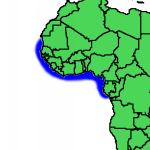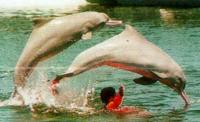 |
|
Genus Sousa
Species of this genus were once classified as Sotalia, but they have recently been separated into a separate genus. Species in the eastern hemisphere were placed under Sousa, while species in the western hemisphere were put in Sotalia. There is significant debate about speciation in this genus. The species are commonly known as hump-backed dolphins, since they have a protrusion that supports the dorsal fin. All hump-backed dolphins share certain characteristics. Adults are between seven and nine feet and weigh less than 150 kg, depending on the population. They have sloping foreheads and long, narrow beaks. | |||||
 Distribution Map
Distribution Map(Click for larger version) |
The Indo-Pacific hump-backed dolphin is not relatively well known. It is found along the coasts of the Indian Ocean and the East Indies, mostly in estuaries. It moves in a leisurely manner and is relatively tame. There is a great deal of disagreement about the taxonomy of the stocks of this species. Three general forms have been identified: a spotted form in the region of South Africa, called by some S. lentiginosa, a solid gray form in the Persian Gulf, called S. plumbea, and a brilliant white form near the China Seas and Sarawak, called S. chinensis. Since the divisions between these stocks are not clear, they are all lumped into a single species. Feeding habits and behavior are not well known, although bottlenose dolphins and hump-backed dolphins have been seen playing together. The social organization is not understood. Groups contain up to 25 individuals, and appear to be somewhat flexible, with relationships between individuals fluctuating. | |||||
 Distribution Map
Distribution Map(Click for larger version) |
As a rather isolated species, the Atlantic hump-backed dolphin is not well known. It is found along the western coast of Africa, from Cameroon north to Senegal and Mauritania. The range may extend as far south as Angola and as far north as 20° N. Within these areas, it makes use of coastal, estuarine, and possibly riverine habitats. The mangrove areas in the south appear to be an important habitat for this species. The taxonomic distinction between this species and the Indo-Pacific hump-backed dolphin is not entirely clear, as they are almost identical. They are termed separate species because the populations appear to be completely isolated, but there are also some craniological differences, such as the number of teeth. All individuals are slaty gray on all sides and slightly paler on the ventral areas. The forehead is smoothly curved, and the beak is long and narrow. Whether females have humps in addition to males is uncertain, as few specimens have been collected. Currently the only major threat to this species is that the mangrove habitats along the coast are threatened. However, because the Atlantic hump-backed dolphin lives along the coasts of some lesser developed countries where there is a high degree of protein deficiency, the potential for greater threats to their survival is present. | |||||
|
BibliographyBaker, Mary L. Whales, Dolphins, and Porpoises of the World. New York: Doubleday & Company, Inc., 1987. Carwardine, Mark. Eyewitness Handbooks: Whales, Dolphins, and Porpoises. New York: Dorling Kindersley Ltd., 1995. Ellis, Richard. Dolphins and Porpoises. New York: Alfred & Knopf, Inc., 1982. Klinowska, Margaret. Dolphins, Porpoises, and Whales of the World: The IUCN Red Data Book. Gland, Switzerland: World Conservation Union, 1991. |
|
© 1998 Thinkquest Team 17963 <17963@advanced.org Modified: 30 August 1998, Created: 30 June 1998 |

 Indo-Pacific Hump-backed Dolphins
Indo-Pacific Hump-backed Dolphins